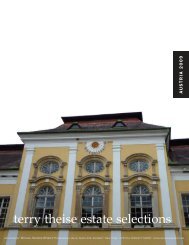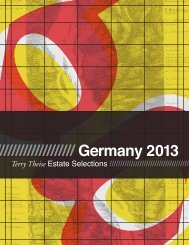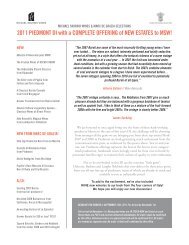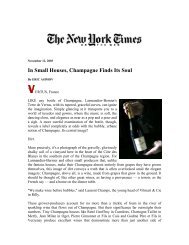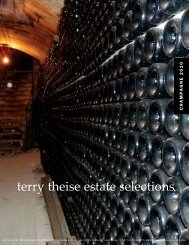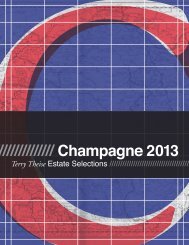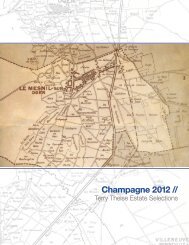German Catalog 2006 USE THIS ONE.qxp - Michael Skurnik Wines
German Catalog 2006 USE THIS ONE.qxp - Michael Skurnik Wines
German Catalog 2006 USE THIS ONE.qxp - Michael Skurnik Wines
You also want an ePaper? Increase the reach of your titles
YUMPU automatically turns print PDFs into web optimized ePapers that Google loves.
NAHE WINES<br />
100<br />
vintage happens before the pressing,” he says. “What<br />
you do afterwards is repair.” He approaches wine<br />
respectfully but not reverentially.<br />
As a vintner he takes his duties completely seriously<br />
and applies himself calmly and fastidiously to his<br />
work. The result is a community of wines as transparent<br />
and filigree as spider webs, but the wonder for Helmut<br />
lies not in the strange fact of such a thing’s existence, but<br />
in the beauty of the workmanship. He wants to make<br />
wine that is pure and serene in flavor.<br />
My friend Robert Houde has a great way to convey<br />
this idea: “People have to get over the idea that intensity<br />
always means volume,” he says. Thank you Robert!<br />
Think of some yahoo blabbing away behind you in a<br />
movie theater. Beyond all patience, you turn to this clod<br />
and whisper, “Would you please SHUT UP?” You haven’t<br />
raised your voice above a whisper, but you have spoken<br />
with seething intensity. Wine does this too. It is always<br />
asking me to shut up.<br />
I loved something Helmut said once: “DAS<br />
GANZE DING MUSS KLINGEN!” That is, the whole<br />
thing must harmonize; it isn’t enough if this part or that<br />
part is interesting or arresting, the whole picture has to<br />
be balanced. Helmut is unaware of it, but he offered<br />
quite a gleaming gift of instruction with that simple little<br />
sentence. We’d all be better wine drinkers—and happier<br />
livers of LIFE—if we could somehow remember:<br />
the whole thing must harmonize.<br />
Dönnhoff ferments with yeast cultures he creates<br />
himself from his own wines, the better to give him the<br />
highest common denominator of controlled, slow fermentation<br />
without having to resort to commercial yeast.<br />
The wines are aged in cask until bottling, but no longer<br />
than six months. If the wine isn’t bottle-ready after six<br />
months it is racked into stainless steel. Low-acid wines<br />
are racked immediately after fermentation; wines with<br />
healthy high acid may sit on the lees as long as a month.<br />
Sounds simple, doesn’t it?<br />
Some Notes On The Vineyards:<br />
“Winemaking alone cannot bring quality, it can only<br />
retain the available quality,” he says, adding: “You can,<br />
however, quickly make bad wine from good fruit if<br />
you’re not attentive in the cellar. We try to make wine of<br />
maximal quality with minimal technology.” He knows<br />
the smallest nuances of flavor are heightened if you pick<br />
for acidity as well as ripeness. “It is the concentration of<br />
all the flavors of the grape, especially the mineral extract,<br />
that gives the wine its real taste and structure,” he says.<br />
“If you have a barrel that’s not so nice, that is the way that<br />
wine is. Standing on your head with technology will not<br />
make it better, and will strip its character.”<br />
This year it was just me and Karen Odessa; no colleagues.<br />
It was snowing and sleeting and low and miserable.<br />
After small-talk we surveyed the vintage. I already<br />
knew it was a great Nahe year, and others had told me<br />
that Helmut was (rarely!) “willing to be pleased” with his<br />
collection. He said “It was one of those years when thunderstorms<br />
were decisive. You had certain vineyards<br />
which seem to have pleased God, and others that seem to<br />
have ticked Him off.” Was it clean, I asked? “The botrytis<br />
itself was clean, but a certain amount of it was always<br />
there; you couldn’t get over 95º without it.” And so we<br />
began to taste.<br />
My sense is that Helmut’s `05s are less sizeable than<br />
others’, less hewn-from-iron. Many of them were pretty<br />
lithe and curvy. Yet what strikes me most is their astonishing<br />
tactile density, a minerality that leaves all thought<br />
of metaphor in the dust: it is so tellingly present you<br />
think the wines were strained through the entire periodic<br />
table of elements. With their rapture of fruit, this<br />
makes for some soul-rending glasses of wine! Yet I was<br />
most of all provoked to laugh, and why shouldn’t laughter<br />
be a soul’s response to astonishment?<br />
This is a thing I find very hard to say. Yet I am moved<br />
to try. With Dönnhoff I rarely if ever sense the wines are<br />
in any way crafted. That implies a guiding intelligence<br />
such as, for instance, I find (and love) at Diel. Dönnhoff’s<br />
In essence the BRÜCKE is a minerally wine; it shows a more masculine profile, it’s more fibrous and nutty<br />
than many other Nahe wines, but just at the moment you think you’re tasting everything in it, it comes at you with<br />
even more nuance, yet another facet of flavor. If new-world-oaky-creamslut wines are like basic addition and subtraction,<br />
these wines are like integral calculus—except that any ragamuffin palate (even mine!) can grok them.<br />
NIEDERHÄ<strong>USE</strong>R HERMANNSHÖLE is one of those vineyards that gives utterly miraculous wine. You shake<br />
your head in delighted perplexity that fermented grape juice can attain such flavors. It is a steep hillside, not very<br />
large (8.5 hectares), with ideal exposition and a soil whose complexity is mirrored in its wines. Walk fifty yards<br />
through the vineyard and you see a mish-mash of soils, as though this were a geological junction, an Arc de<br />
Triomphe of slate, porphyry, melaphyre and conglomerates—sometimes all jumbled together. The only possible<br />
drawback is drought in the drier years. Its favorable exposure makes Eiswein almost impossible.<br />
Dönnhoff is currently producing the very best wines from HERMANNSHÖLE, and you need look no further<br />
to see one of the wine-world’s great confluences of a great vineyard and a great proprietor. I don’t care what a hotshot<br />
palate you have, the complexities of these wines will tax it to its outermost limits. The fundamental aromas<br />
and flavors are a mingling of sharply sweet cherry, sometimes black cherry, and currant-cassis, but there is a hint<br />
of anise too, something spriggy, and an undertow of stoniness from the slate. Botrytis brings tropical fruit notes.<br />
I would go so far as to claim that NO SINGLE WINE IN THE ENTIRE WORLD IS AS COMPLEX AS<br />
DÖNNHOFF’S BEST FROM HERMANNSHÖHLE.



